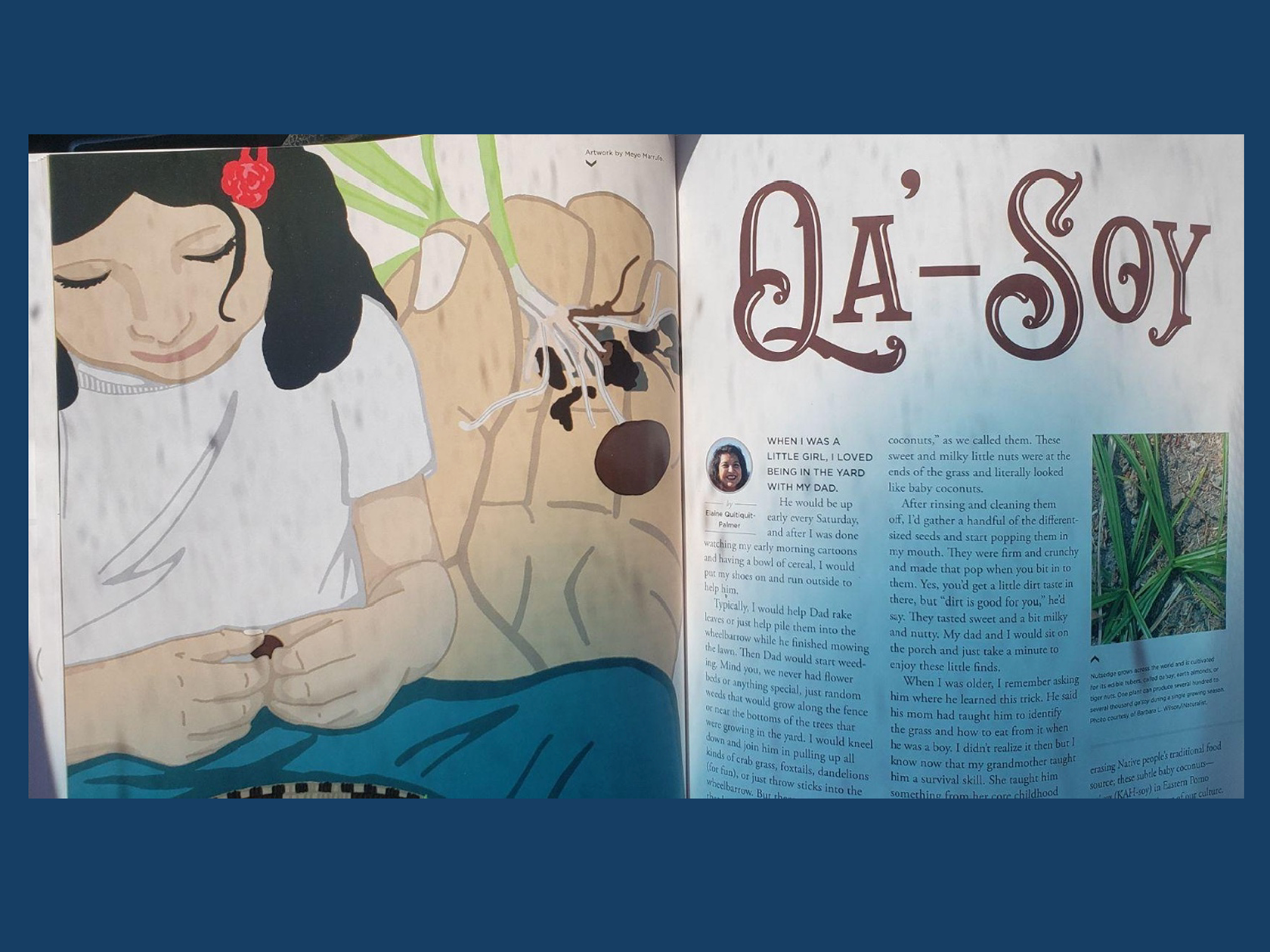Overview
Qa'-Soy: a Pomo Tale of Traditional Ecological Knowledge

Contributors:
- Author: Elaine Quitiquit-Palmer (Pomo)
- Artist: Meyo Marrufo (Pomo)
- Lesson support and edited by Rebecca Lowry, (Lenape) Learning Specialist, Humboldt County Office of Education
Grades: 4-5
Suggested Amount of Time: 1 Week
Curriculum Themes
- History
- Cultural Strengths
- Relationship to Place
Learning Goals
- Students will gain understanding of a Pomo cultural practice as well as their own family traditions and history.
- Students will learn how to identify “Elders” in their families and interact with them in a respectful manner.
Lesson Overview
This 3 part unit was written by Pomo educator, weaver and artist, Elaine Quitquit Palmer. A story recollecting a cherished childhood memory, with her father, is the focal point.
The story of Qa’-Soy illustrates the passing on of traditional knowledge. Students will read this story and interview an elder in their community. Some students will have a grandparent they can ask about traditions in their family. If a family member is not available, the teacher can help the student identify an appropriate community member the student may interview.
Elders are highly respected in California Native American culture. They remember our history and teach culture, share stories, and pass down traditional knowledge. It is important for the youth today to learn how to respect and communicate with their elders so that they maintain their family histories.” Elaine Quitquit Palmer
Teacher Background
Geography
For over 10,000 years Lake county has been inhabited by Pomo people in the North central portion of California. There were various bands of pomo located around Clear Lake, one of the oldest natural water lakes in California.
History/Background
The mid 1800’s commenced a period of colonial violence due to the Gold Rush and assimilation practices that sent many Pomo children away from their homes. Most children were sent to boarding schools throughout California. The Gold Rush brought in more settlers to the area in Lake county. The Pomo population began to dwindle due to sickness, slavery and outright killings by these foreign settlers.
In 1847, settlers Andrew Kelsey and Charles Stone established a ranching operation in Clear Lake, exploiting Pomo labor through enslavement, starvation, and sexual violence. After Kelsey and Stone murdered a young Pomo man seeking food for his family in late 1849, Chief Augustine and others retaliated by killing the two settlers. This act of resistance prompted a brutal U.S. military response. On May 15, 1850, Lieutenant Nathaniel Lyon led the 1st Dragoons Regiment to *Badon-napoti* (Bloody Island), where they massacred approximately 800 Pomo, primarily elders, women, and children. Today there is a marker off of Highway 20 that memorializes those that were massacred on that day. Not far from there is the Robinson Rancheria Casino and rancheria.
At present, Robinson Rancheria Band manages approximately 1,010 acres in Lake County, blending economic development with cultural revitalization. Initiatives like the Clear Lake hitch conservation program address ecological threats to culturally vital fish species, while gaming enterprises fund language preservation and intergenerational education. These efforts underscore the tribe’s resilience—a continuity of resistance that bridges ancestral traditions and modern self-determination.
Culture
Pomo were known for their fishing and hunting skills and for their intricate art of basketry work and were thriving on the lands around Clear lake. Today many pomo are bringing traditional skills back and are teaching youth how to make baskets from willow and tule, how to create tule canoes, teaching them how to gather traditional foods and medicine and passing down traditional ecological knowledge like cultural burning and land stewardship.
The Robinson Rancheria Band’s history is a testament to the Pomo people’s resolve to protect their heritage, lands, and future.

